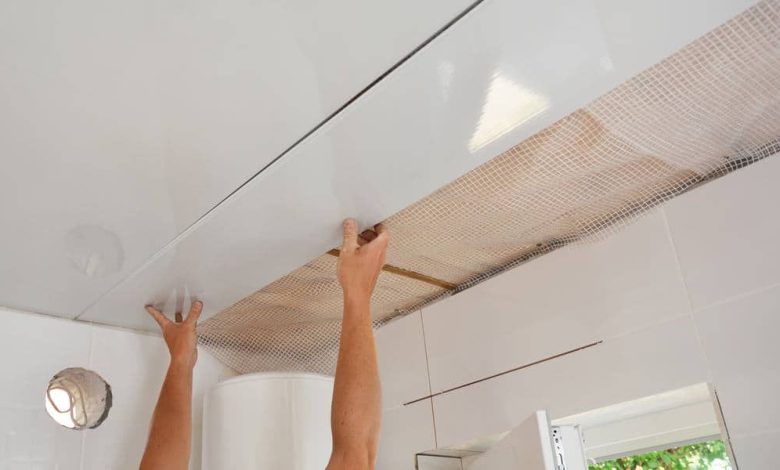Which is Best Ceiling for Bathroom?

When it comes to bathroom design and renovation, homeowners often prioritize elements like fixtures, tiles, and countertops. However, one crucial aspect that tends to be overlooked is the ceiling. The right ceiling can significantly enhance the overall aesthetic and functionality of your bathroom while also addressing practical concerns like moisture resistance and maintenance.
In this guide, we’ll talk about various Ceiling Tiles for Bathroom, discussing their pros, cons, and suitability to help you make an informed decision that suits both your style and needs.
Considerations for Bathroom Ceilings
Before diving into specific ceiling materials, it’s essential to understand the key considerations that should guide your choice:
- Moisture Resistance: Bathrooms are inherently humid spaces, making moisture resistance a critical factor. A bathroom ceiling must be able to withstand constant exposure to steam and water to prevent issues like mold growth and material degradation.
- Ventilation: Proper ventilation helps in reducing humidity levels in the bathroom. A well-ventilated bathroom not only maintains a healthier environment but also extends the lifespan of your chosen ceiling material.
- Aesthetic Appeal: The ceiling is an integral part of the overall bathroom design. It should complement the style you’re aiming for, whether it’s modern, traditional, minimalist, or something else entirely.
- Maintenance: Bathrooms require regular cleaning due to the accumulation of moisture and grime. The ceiling material should be easy to clean and not require excessive maintenance.
- Budget: Different ceiling materials come at various price points. It’s essential to choose an option that aligns with your budget for the renovation project.
Popular Bathroom Ceiling Options
Let’s explore some of the most popular ceiling options for bathrooms, along with their advantages and disadvantages:
1. Painted Drywall:
Advantages:
- Cost-effective and readily available.
- Can be painted in any color to match your bathroom’s decor.
- Installation is relatively straightforward.
Disadvantages:
- Prone to moisture damage, especially if not properly sealed.
- May require regular repainting to maintain its appearance.
- Not the most durable option for humid environments.
2. PVC Panels:
Advantages:
- Highly moisture-resistant and durable.
- Easy to clean, requiring minimal maintenance.
- Wide variety of designs and textures available.
- Can be DIY-installed in some cases.
Disadvantages:
- May look less sophisticated compared to other materials.
- Quality can vary, so it’s essential to choose a reputable brand.
- Installation might require special tools and skills for a professional finish.
3. Metal Ceilings:
Advantages:
- Excellent moisture resistance.
- Stylish and contemporary appearance.
- Resistant to mold and mildew.
- Reflective surfaces can enhance lighting in the bathroom.
Disadvantages:
- Generally higher cost compared to some other options.
- Professional installation is recommended, adding to the overall expense.
- Can create a noisy environment due to sound reverberation.
4. Tile Ceilings:
Advantages:
- Offers a seamless look if extending tile from walls to ceiling.
- Wide range of tile materials and designs available.
- Highly moisture-resistant, especially if sealed properly.
- Durable and long-lasting.
Disadvantages:
- Installation can be complex and time-consuming.
- Grout lines between tiles can be challenging to clean.
- Higher cost due to materials and labor involved.
5. Suspended Ceilings:
Advantages:
- Conceals unsightly plumbing, wiring, and other installations.
- Provides easy access to plumbing and wiring for repairs.
- Offers good moisture resistance.
Disadvantages:
- May reduce the ceiling height, making the bathroom feel smaller.
- Limited design options compared to other materials.
- Installation can be complex and might require professional assistance.
Making the Right Choice
Choosing the best ceiling for your bathroom involves balancing aesthetics, functionality, and budget. Here are some tips to help you make the right choice:
- Prioritize Moisture Resistance: Given the humid nature of bathrooms, opt for materials that are highly moisture-resistant. PVC panels, metal ceilings, and tile ceilings are among the top choices in this regard.
- Consider Aesthetics: Your chosen ceiling should complement the overall bathroom design. If you’re going for a modern look, metal or suspended ceilings might be suitable. For a more traditional vibe, consider tile ceilings.
- Evaluate Maintenance Requirements: Think about how much time and effort you’re willing to invest in maintaining the ceiling. Painted drywall requires more frequent maintenance, while PVC panels and metal ceilings are easier to clean.
- Budget Wisely: Set a budget for your bathroom renovation project and allocate a portion of it to the ceiling. Remember that some materials might require professional installation, which can add to the overall cost.
- DIY vs Professional Installation: Consider your DIY skills and the complexity of the installation process. While some options like PVC panels can be DIY-installed, others like suspended ceilings might require professional assistance.
Conclusion
In the realm of bathroom design, the ceiling is a vital component that deserves careful consideration. By weighing factors like moisture resistance, ventilation, aesthetics, maintenance, and budget, you can select the best ceiling option that aligns with your preferences and practical needs.
Whether you opt for the classic appeal of tile ceilings, the modern touch of metal, the convenience of PVC panels, or the functionality of suspended ceilings, your chosen ceiling can elevate the ambiance of your bathroom while ensuring its durability and functionality for years to come.
Also Read: What Are the Most Commonly Used Types of Ceiling Grid Systems?



